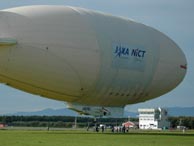 |
This past May, we were able to show our test airship to the media and local residents in a hanger at the Multi-purpose Aviation Park in the town of Taiki in Hokkaido. The airship, designed to remain at a designated point in the air, is part of our Stratosphere Platform Project.
We were very happy to see that visitors who saw the airship at close range were impressed by the near 70-meter long aircraft. From that time, and when we started testing, we received many different questions. Some are very simple, while others hit on some points that we have been working on very hard. We were very pleased to be asked such interesting questions.
I would like to explain the airship and the Stratosphere Platform Project by answering some of those questions.
|
|

A: First of all, the prerequisites for airship liftoff and landing are stable weather conditions and broad areas. In the town of Taiki, wind is relatively calm throughout the year, making it an idealistic place for handling an airship. In addition, the town is equipped with a huge and very well maintained "Multi-purpose Aviation Park" consisting of 470,000 square meters with a 1,000-meter runway. We are very grateful that we can use such a facility almost exclusively to ourselves.
Since the park is away from regular aviation routes, many private companies and research institutes have implemented their prototype tests there. JAXA has been familiar with this park since we were the National Aerospace Laboratory, one of the three former organizations that merged to form JAXA. The above weather conditions and broad areas are important factors, but the biggest reason to carry out the test here is the fact that not only the town government but also the local residents show tremendous enthusiasm, goodwill and understanding toward the aerospace industry.
![Q: An airship or blimp seems to be a very [free and easy] type of aircraft, but is it actually very difficult to fly?](img/p1_subtitle02_e.gif)
A: Impact from the wind is very critical because the projection of the airship is quite large. For example, if the wind velocity is one meter per secondhour, 35 kgf of wind pressure is on the airship. If it is three meters per secondhour, however, the pressure becomes 10 times stronger at 350 kgf. A crew of 12 to 16 people is required to pull such an airship out of the hanger, in the same manner as leading a horse by the reins. It is then released into the air.
The airship seems to fly "freely and easily" because of the impression of commercial advertisement blimps that fly low in the sky slowly and easily in an altitude as low as several hundred meters.
On the other hand, for our Stratosphere Platform Project, we aim for an altitude two digits higher. Therefore, every aspect of the airship, ranging from materials for the outer film, the structure, and flight control, is completely different. If I am asked, "Is it a tough job?" my honest answer is, "Yes!" We have to strive to make achievements by challenging the unknown world while paying the utmost attention to ground and flight safety.
|
 Flight test image (no sound)
Flight test image (no sound)
(RealPlayer File:6.97Mbyte)
(mpg File:7.10Mbyte)

Collaborative project with the
National Institute of Information
and Communications
Technology (NICT)
|
 |
1/3 |
 |
|
 |

